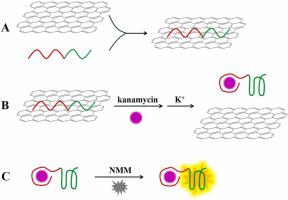当前位置:
X-MOL 学术
›
J. Food Compos. Anal.
›
论文详情
Our official English website, www.x-mol.net, welcomes your
feedback! (Note: you will need to create a separate account there.)
Low-background fluorescent biosensor based on graphene oxide and aptamer biorecognition for sensitive detection of kanamycin
Journal of Food Composition and Analysis ( IF 4.0 ) Pub Date : 2024-04-18 , DOI: 10.1016/j.jfca.2024.106261 Wanling Cui , Churuo Hu , Rui Zhu , Dewen Qiu , Ruihong Gong , Rui Wang , Qiang Li , Tingting Yan , Chonghui Li , Mei Qiao , Shicai Xu
Journal of Food Composition and Analysis ( IF 4.0 ) Pub Date : 2024-04-18 , DOI: 10.1016/j.jfca.2024.106261 Wanling Cui , Churuo Hu , Rui Zhu , Dewen Qiu , Ruihong Gong , Rui Wang , Qiang Li , Tingting Yan , Chonghui Li , Mei Qiao , Shicai Xu

|
The detection of kanamycin has attracted extensive attention in the field of food safety. A label-free, low-background fluorescent biosensor was successfully constructed based on graphene oxide and aptamer biorecognition in this paper for kanamycin detection in milk samples. In this biosensor, the integrated probe with the aptamer sequence of kanamycin and the G-rich sequence was designed. The aptamer sequence of kanamycin was used as the recognition part, the G-quadruplex/N-methyl mesoporphyrin IX (NMM) complex as the fluorescent probe, and graphene oxide as the fluorescent quencher. Initially, the integrated probe could be adsorbed on the graphene oxide surface through π-π stacking interactions, while the fluorescence of NMM could be efficiently quenched because of the resonance energy transfer between NMM and graphene oxide, which was beneficial to the low background signal of the system. During the detection process, the aptamer sequence preferred to bind to kanamycin, forming aptamer-kanamycin complex. At the same time, the G-rich sequence folded into G-quadruplex structure that specifically bound to NMM under the action of K, forming G-quadruplex/NMM complex. Under the synergistic effects of the two complexes, the integrated probe with aptamer-kanamycin complex and G-quadruplex/NMM complex was released from the graphene oxide surface due to the steric hindrance effect, restoring the strong fluorescence signal. By combining graphene oxide and G-quadruplex/NMM complex, the fluorescent biosensor could effectively achieve label-free and low-background detection of kanamycin. The linear calibration curve was in the range of 1–400 nM with a detection limit of 0.60 nM for kanamycin. It was successfully applied to analyze raw milk samples (spiked kanamycin) with recoveries of 98.33–101.25 % and also exhibited high selectivity for kanamycin. The experimental data showed that the biosensor was a potentially powerful tool for monitoring food safety.
中文翻译:

基于氧化石墨烯和适体生物识别的低背景荧光生物传感器用于灵敏检测卡那霉素
卡那霉素的检测引起了食品安全领域的广泛关注。本文成功构建了一种基于氧化石墨烯和适配体生物识别的无标记、低背景荧光生物传感器,用于牛奶样品中卡那霉素的检测。在该生物传感器中,设计了带有卡那霉素适配体序列和富含G序列的集成探针。以卡那霉素适配体序列为识别部分,G-四链体/N-甲基中卟啉IX(NMM)复合物为荧光探针,氧化石墨烯为荧光猝灭剂。最初,集成探针可以通过π-π堆积相互作用吸附在氧化石墨烯表面,而NMM的荧光由于NMM和氧化石墨烯之间的共振能量转移而可以被有效猝灭,这有利于NMM的低背景信号系统。在检测过程中,适配体序列优先与卡那霉素结合,形成适配体-卡那霉素复合物。同时,富含G的序列折叠成G-四链体结构,在K的作用下与NMM特异性结合,形成G-四链体/NMM复合物。在两种复合物的协同作用下,适配体-卡那霉素复合物和G-四联体/NMM复合物的集成探针由于空间位阻效应从氧化石墨烯表面释放,恢复了强荧光信号。通过结合氧化石墨烯和G-四联体/NMM复合物,荧光生物传感器可以有效实现卡那霉素的无标记和低背景检测。卡那霉素的线性校准曲线范围为 1–400 nM,检测限为 0.60 nM。它成功应用于分析原料奶样品(加标卡那霉素),回收率为 98.33-101.25%,并且对卡那霉素也表现出高选择性。实验数据表明,生物传感器是监测食品安全的潜在强大工具。
更新日期:2024-04-18
中文翻译:

基于氧化石墨烯和适体生物识别的低背景荧光生物传感器用于灵敏检测卡那霉素
卡那霉素的检测引起了食品安全领域的广泛关注。本文成功构建了一种基于氧化石墨烯和适配体生物识别的无标记、低背景荧光生物传感器,用于牛奶样品中卡那霉素的检测。在该生物传感器中,设计了带有卡那霉素适配体序列和富含G序列的集成探针。以卡那霉素适配体序列为识别部分,G-四链体/N-甲基中卟啉IX(NMM)复合物为荧光探针,氧化石墨烯为荧光猝灭剂。最初,集成探针可以通过π-π堆积相互作用吸附在氧化石墨烯表面,而NMM的荧光由于NMM和氧化石墨烯之间的共振能量转移而可以被有效猝灭,这有利于NMM的低背景信号系统。在检测过程中,适配体序列优先与卡那霉素结合,形成适配体-卡那霉素复合物。同时,富含G的序列折叠成G-四链体结构,在K的作用下与NMM特异性结合,形成G-四链体/NMM复合物。在两种复合物的协同作用下,适配体-卡那霉素复合物和G-四联体/NMM复合物的集成探针由于空间位阻效应从氧化石墨烯表面释放,恢复了强荧光信号。通过结合氧化石墨烯和G-四联体/NMM复合物,荧光生物传感器可以有效实现卡那霉素的无标记和低背景检测。卡那霉素的线性校准曲线范围为 1–400 nM,检测限为 0.60 nM。它成功应用于分析原料奶样品(加标卡那霉素),回收率为 98.33-101.25%,并且对卡那霉素也表现出高选择性。实验数据表明,生物传感器是监测食品安全的潜在强大工具。

































 京公网安备 11010802027423号
京公网安备 11010802027423号